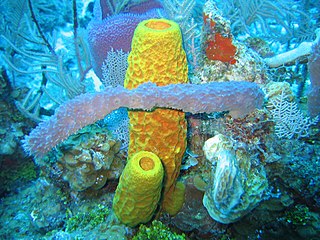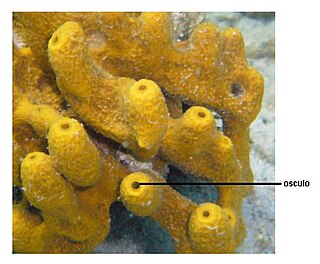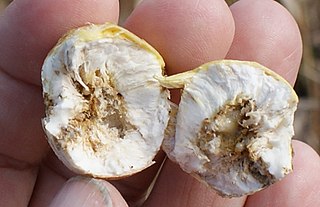
Anheteromeyenia argyrosperma is a freshwater sponge found across North America.
The crumb-of-bread sponge is a species of sponge in the class Demospongiae.
Borojevia paracerebrum is a species of calcareous sponge from Mexico. The species is named after its similarity to Borojevia cerebrum.
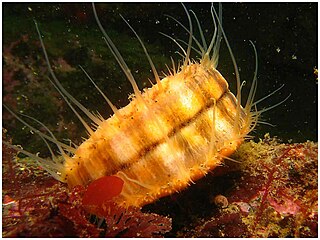
Chlamys hastata, the spear scallop, spiny scallop or swimming scallop, is a species of bivalve mollusc in the family Pectinidae found on the west coast of North America from the Gulf of Alaska to San Diego, California. A limited number of these scallops are harvested by divers or by narrow trawls off the west coast of Canada.
The red encrusting sponge, Clathria (Isociella) oudekraalensis, is a species of demosponge. It is known only from the South African coast, on both sides of the Cape Peninsula. It is endemic to this region.
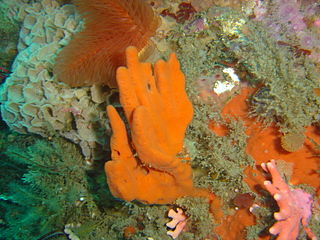
The flat leaf sponge is a species of marine demosponge in the family Isodictyidae. This sponge is known from the west coast of South Africa to False Bay. It is endemic to this region.
The yellow encrusting sponge, Biemna anisotoxa, is a species of marine demosponge in the family Desmacellidae. This sponge is known from the west coast of South Africa to Port Elizabeth. It is endemic to this region.

The encrusting turret sponge, is a species of demosponge. It is known around the southern African coast, from Namibia to the South African south coast.
Suberites ficus is a species of sponge in the family Suberitidae. It is sometimes known as the sea orange sponge.

Myxilla incrustans is a species of demosponge. It is an encrusting species and is usually yellow.

Cyrtopleura costata, or the angel wing clam, is a bivalve mollusc in the family Pholadidae. It is found in shallow parts of the northwest Atlantic and also in the North Sea of Scotland coastline and west coast of the Adriatic Sea by a remote area in the Marche region in central Italy, living in the seabed, where it digs its burrows on a very slow revolving movement for years through soft sand and mud stone always to a max depth of 8ft but always below 3 feet (0.91 m) at the lowest tide.
Mycale grandis, the orange keyhole sponge, is a species of marine demosponge in the family Mycalidae. Mycale is a large genus and this species is placed in the subgenus Mycale making its full name, Mycale (Mycale) grandis.

Pachymatisma johnstonia is a species of demosponge belonging to the family Geodiidae. A species of north east Atlantic coasts, this is a usually grey encrusting sponge with large prominent oscula and a pale yellow interior. The size and form depends largely on the extent of its exposure to waves. In heavily wave-exposed locations, it is usually small and thin but in more sheltered places can grow to over 50 cm across and 15 cm thick.
Neofibularia nolitangere, the touch-me-not sponge, is a species of demosponge in the family Biemnidae. It is found in shallow waters in the Western Atlantic Ocean and the Caribbean Sea.

Cliona viridis, commonly called the green boring sponge, is a species of demosponge in the family Clionaidae. Its form varies according to the nature of the surface on which it grows. In limestone and other calcareous substrates it excavates channels and chambers while on other types of rock it encrusts the surface or forms massive structures. It is native to the eastern Atlantic, the Mediterranean Sea and the Indo-Pacific Ocean.
Conopeum seurati is a species of colonial bryozoan in the order Cheilostomata. It is native to the northeastern Atlantic Ocean, the North Sea and the Mediterranean Sea. This species has been introduced to New Zealand and Florida.

Haliclona (Soestella) cearulea is a species of marine sponge in the family Chalinidae. It is an encrusting tubular sponge that grows anchored on rocky surfaces of coral reefs.

Clathria prolifera, commonly known as red beard sponge, is a species of demosponge in the family Microcionidae. It is native to shallow water habitats in the western Atlantic Ocean from Prince Edward Island southwards to Florida and Mexico, and possibly Brazil. In the twentieth century it also became established on the west coast of the United States.
Agelas tubulata is a species of demosponge. It is tube-shaped or vase-shaped and variable in colour. It is found in the Caribbean area and along the coasts of Brazil at depths of between about 70 and 90 m. It was first described by Lehnert & van Soest in 1996, the type location being the Greater Antilles.

Oscarella lobularis is a species of sponge in the order Homosclerophorida. It is native to the northeastern Atlantic Ocean and the Mediterranean Sea, where it forms encrusting colonies on rocks and other hard surfaces.
